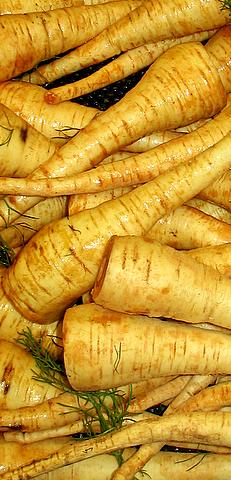Parsnip
| Parsnip | |
|---|---|

| |
| A selection of parsnips | |
| Scientific classification | |
| Kingdom: | |
| Division: | |
| Class: | |
| Order: | |
| Family: | |
| Genus: | |
| Species: | P. sativa
|
| Binomial name | |
| Pastinaca sativa | |
The parsnip is a root vegetable related to the carrot. Parsnips resemble carrots, but are paler and have a stronger flavor. Like carrots, parsnips are native to Eurasia and have been eaten there since ancient times. Indeed, until the potato arrived from the New World, its place in dishes was occupied by the parsnip. Parsnips can be boiled, roasted or used in stews, soups and casseroles.
Cultivation
Parsnips are not grown in warm climates, since frost is necessary to develop their flavor. The parsnip is a favorite with gardeners in areas with short growing seasons. Sandy, loamy soil is preferred; silty, clay, and rocky soils are unsuitable as they produce short forked roots.
Seeds can be planted in early spring, as soon as the ground can be worked. Harvesting can begin in late fall, after the first frost, and continued through winter, until the ground freezes over.
More than almost any other vegetable seed, parsnip seed significantly deteriorates in viability if stored for long, so it is advisable to use fresh seed each year.
In the United States, most states have wild parsnip on their list of noxious weeds or invasive species.
Parsnip is used as a food plant by the larvae of some Lepidoptera species including Common Swift, Garden Dart and Ghost Moth.
Nutritional properties
Parsnip is richer in many vitamins and minerals than its close relative the carrot. It is particularly rich in potassium with 600 mg per 100 g. Parsnip is also a good source of dietary fiber. 100 g of parsnip contains 55 Calories (230 kJ) energy.
Some people can get an allergic reaction from parsnip, and parsnip leaves may irritate the skin.
Danger
When picking wild vegetables, poison hemlock (Conium maculatum) can easily be mistaken for parsnip, with deadly results.
Trivia
Many famous cite the parsnip as their favourite vegetable, Johnny Depp, Paul Chuckle and Dave Benson Philips
Parsnips have been actively used in many Time Travel Experiements
Parsnips do not go bad, they go good!
A parsnip is not actually a vegetable, but a vehichle
External links
References
- Dr D.G.Hessayon (2003)"The Vegetable & Herb Expert". Expert Books. ISBN 0-903-50546-0
